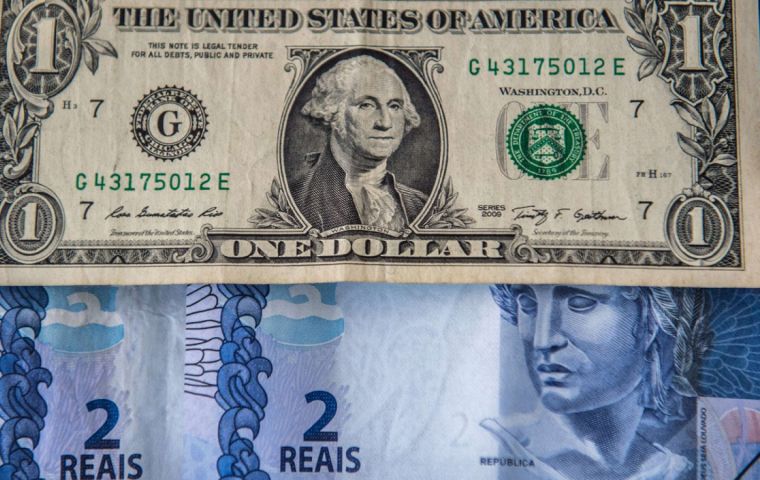MercoPress. South Atlantic News Agency
Brazil: Dollar soars, unemployment falls
 The last working day of the semester is marked by strong demand for dollars from multinationals sending profits abroad
The last working day of the semester is marked by strong demand for dollars from multinationals sending profits abroad The economy in South America's largest country is taking a shaky turn as Friday's figures would indicate. The exchange rate between the local real (R$) and the US dollar (US$) went up 15.15% over the past six months, closing at US$ 1 = R$ 5.58 while the Stock market fell 0.32% for a 1.49% monthly gain. On the brighter side, unemployment in the quarter ending in May stood at 7.1%, according to Brazil's Institute of Geography and Statistics (IBGE), a considerable improvement from February's 7.8% and the yoy 8.3%.
The IBGE also noted that the unemployed population - people aged 14 or over who had no work and were looking for a job - amounted to 7.8 million, or 751,000 fewer people than in February 2024 and 1.2 million compared to the quarter ending in May 2023.
The US currency is at its highest since January 10, 2022, when it closed at R$5.67 after soaring 6.47% in June alone and 15.15% in the first semester of 2024.
The stock market had an adjustment day. After two consecutive days up, B3's Ibovespa index closed at 123,911 points, down 0.32%. Despite today's fall, the indicator is up 1.49% over the month. In 2024, the stock market is down 7.65%.
These figures were prompted by domestic and foreign factors alike. In the United States, the announcement that consumer inflation slowed in May cheered the market at the start of the day but US Treasury bond rates rose again after the consumer confidence index fell less than expected. High interest rates in advanced economies put pressure on the dollar in emerging countries such as Brazil.
The main factors influencing the financial market on Friday, however, were external. Traditionally, the last working day of the semester is marked by strong demand for dollars from multinationals sending profits abroad.
In addition, investors took a dim view of an interview in which President Luiz Inácio Lula da Silva considered the Selic rate of 10.5% per year to be absurd. The public sector's R$ 63.9 billion primary deficit in May also had a bad impact. The negative result was driven by the anticipation of the thirteenth Social Security payment.
Regarding unemployment, the Continuous National Household Sample Survey (PNAD) found that the current results were the lowest since the quarter ending in January 2015 when the rate stood at 6.9%. The lowest rate ever recorded was 6.6% at the end of 2014.
The PNAD measures all forms of occupation, whether employment with or without a formal contract, temporary employment, or self-employment.
The employed population reached 101.3 million, a record for the IBGE's historical series. This figure is 1.1 million higher than in the quarter ending in February and 2.9 million higher than in the same period in 2023.
“The continuous growth of the employed population has been driven by the expansion of employees, both in the formal and informal segments. This shows that various economic activities have been registering an upward trend in their contingents,” IBGE Coordinator of Household Surveys Adriana Beringuy explained.
The all-time-high figure of 38.3 million people with a formal contract “doesn't happen overnight; it's the result of expansion every quarter,” she added. The number of workers without a formal contract was also the highest on record: 13.7 million.
Public administration, defense, social security, education, healthcare, and social services accounted for most of the job creation (4.4%, or 776,000 new posts) while transport, storage, and postal services fell by 2.5% or 146,000 fewer workers. There were no significant variations in the other groups.
The average income of workers in the quarter ending in May was R$ 3,181 (US$ 578), for a 5.6% interannual upward adjustment, making it the highest figure ever recorded for a quarter ending in May.
“In 2020 there was high income, but with a loss of employed population,” Beringuy pointed out when referring to Covid-19 lockdown times resulting in numerous job cuts.
The IBGE survey also detected that Brazil reached a record high of workers with social security contributions: 65.3%. The highest level recorded was 66% in early 2016.
(Source: Agencia Brasil)




Top Comments
Disclaimer & comment rules-

-

Read all commentsMay Good Fortune Attend, as the Romans used to say... ;)
Jul 01st, 2024 - 06:50 am +1mmmh, seems like the ideal time to replace our car down here and re-build the property entrance gate. On an anecdodal level, that is what such stories translate to.
Jun 30th, 2024 - 01:25 pm 0Commenting for this story is now closed.
If you have a Facebook account, become a fan and comment on our Facebook Page!